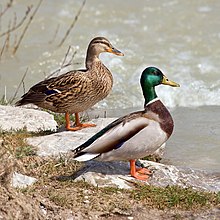Mallard duck
| Mallard | |
|---|---|
 |
|
| Female (left) and male (right) | |
| Scientific classification | |
| Kingdom: | Animalia |
| Phylum: | Chordata |
| Class: | Aves |
| Order: | Anseriformes |
| Family: | Anatidae |
| Subfamily: | Anatinae |
| Genus: | Anas |
| Species: | A. platyrhynchos |
| Binomial name | |
|
Anas platyrhynchos Linnaeus, 1758 |
|
| Subspecies | |
|
A. p. platyrhynchos Linnaeus, 1758 |
|
 |
|
| Global range (native and introduced) Year-Round Range Summer Range Winter Range | |
| Synonyms | |
|
Anas boschas Linnaeus, 1758 |
|
A. p. platyrhynchos Linnaeus, 1758
A. p. domesticus Linnaeus, 1758
A. p. conboschas C. L. Brehm, 1831 (disputed)
Anas boschas Linnaeus, 1758
The mallard (/ˈmælɑːrd/ or /ˈmælərd/) or wild duck (Anas platyrhynchos) is a dabbling duck which breeds throughout the temperate and subtropical Americas, Eurasia, and North Africa, and has been introduced to New Zealand, Australia, Peru, Brazil, Uruguay, Argentina, Chile, the Falkland Islands and South Africa. This duck belongs to the subfamily Anatinae of the waterfowl family Anatidae.
The male birds (drakes) have a glossy green head and are grey on wings and belly, while the females (hens or ducks) have mainly brown-speckled plumage. Both sexes have an area of white-bordered black speculum feathers which commonly also include iridescent blue feathers especially among males. Mallards live in wetlands, eat water plants and small animals, and are social animals preferring to congregate in groups or flocks of varying sizes. This species is the main ancestor of most breeds of domesticated ducks.
...
Wikipedia

